|
|
|
|
|
|
WWI Memorial Charts Path Forward
National Women’s History Museum Suffragettes Walking Tour in DC highlights WWI connections
 The history of Women's Rights in America, and of World War I are directly linked. Now, to help tell that story, there is a new hidden treasure for
those who live near Washington DC or for those visiting: a walking tour
presented by The National Women’s History Museum is now occurring every
other week on Friday and once a month on Saturday. World War I Centennial Commission intern Miranda Halpin took the tour, and provides a list of the top stops that help explain how the Suffragettes supported both their nation at war and the cause of Votes for Women. Read the entire article here.
|
 Born to a wealthy family, and only ever attending private schools for America’s most elite, this young man was a terrible student, uninterested in applying
himself in school or in any extra-curricular activities.
Even so, he was bound for Yale
University until misbehavior at the end of his high school career removed college as an opportunity. With no other good option, young Humphrey Bogart joined the US Navy in 1918, and turned his life around while serving in WWI as "an exemplary sailor." In post-war Hollywood, Bogart became an iconic figure. Read more about Humphrey Bogart in the third of our series on Hollywood and WWI here.
|
 The Choctaw Nation made history earlier this year with the dedication of
the Joseph Oklahombi World War I Code Talker Bridge in McCurtain
County, Oklahoma. The dedication, attended by the Choctaw Tribal Council, tribal members, local city and county and state officials, is the first of 23 bridges being named after the 19
Choctaw Code Talkers from World War I and four from World War II, by the
Oklahoma Department of Transportation, the biggest bridge undertaking in the history of the Department. Read more about the Oklahoma recognition of Joseph Oklahombi (pictured at right) and other Choctaw the Code Talkers here.
|
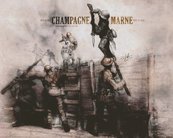 America's entry into World War I began with a year-long buildup
beginning in April 1917. By late spring and early summer of 1918, that
buildup was nearly complete.
In response, the Germans launched a series of offensives, desperate
to defeat the French, British and other allies. One of the final German pushes occurred in the early morning hours of
July 15, 1918, in the Champagne-Marne area of northern France, where
German assault troops and artillery pounded the U.S. 3rd Division lines. The weight of the attack came against Col. Edmund Butts' 30th Infantry and Col. Ulysses Grant McAlexander's 38th Infantry. Read more about how the men of these units earned the sobriquet "Rock of the Marne" with their heroism here.
|
From the World War I Centennial News Podcast
Update from the States: An Interview with the Delta Cultural Center's Drew Ulrich
 In July 20th's WW1 Centennial News Podcast, Episode 81, Drew Ulrich, the curator of the Delta Cultural Center in Arkansas, spoke with host Theo Mayer about a new exhibit honoring Delta region residents who served in the Great War. Click here to read a transcript of the interview.
|
Photography in the Great War
 In July 20th's WW1 Centennial News Podcast, Episode 81, we focused primarily on photography: its effect on the war, a modern curation project, and even an addition to our vernacular. Corine Reis, a French public historian, spoke with host Theo Mayer about her WW1 photography blog, Waldo Pierce Goes to War. Later in the show, we dug into the importance of photography to military operations and personal photography among soldiers in WW1 Tech, and examined the word "snapshot." Click here to read a transcript of the interview, followed by WW1 Tech and Speaking WW1.
|
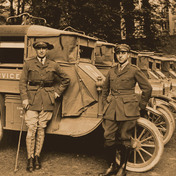
Episode #82
Highlights: Ambulance
100 Years Ago: Ambulance | @02:15
American Field Service - Nicole Milano | @08:15
Great War Channel: Hemingway - Indy Neidell | @15:00
Great War Project: But Paris is safe - Mike Shuster | @16:05
America Emerges: Who’s fighting where - Dr. Edward Lengel | @19:50
Commission News: WWI Commemorative Stamp - Rebekah Wilson | @25:50
State Update: Michigan “Over There” event features the maquette | @33:30
Spotlight on the media: New book: Good War, Great Men - Andrew Capets | @34:35
100 Cities / 100 Memorials: Cape May, NJ - Kathleen Wyatt & Harry Bellangy | @39:30
Speaking WWI & WWI War Tech : Ambulance | @45:10
Articles & Posts: Weekly Dispatch Newsletter | @50:05
The Buzz - Centennial Social Media - Katherine Akey | @53:30
|
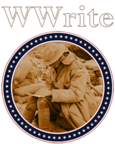 Of the Dreadnoughts by Jeffrey Hess
Dreadnoughts. A baseball team? A guitar? A band? While Navy veteran and writer, Jeffrey Hess was researching the Cold War for his next novel, he came upon information about Dreadnoughts, battleships used during WWI. This week at WWrite, Hess, author of Beachhead, Tushhog, and the short-story collection, Cold War Canoe Club, navigates us through one of the less familiar stories of WWI about the U.S. Navy and its formidable Dreadnoughts. Read this interesting and compelling post about these massive WWI battleships.
|
 A man is only missing if he is forgotten.
Monday's MIA this week is Corporal
Clarence Hawkins. Born
August 17th, 1898, Corporal Hawkins was a Miner in Huntingtonburg, Indiana when
he was enlisted in the regular army on November 13th, 1916 at Columbus
Barracks, Ohio. Assigned to Company C, 28th Infantry, 1st Division, and went to
France with the first American combat contingent to go over in June, 1917. He
was killed in action by shell fire on May 30th, 1918 during the Battle of
Cantigny, America's first planned offensive action of the war, while going over
the top for the 4th time. His remains were buried there on the battlefield
where he fell, but later were never located.
Can you spare just ten
dollars? Give 'Ten For Them' to Doughboy MIA and help us make a full
accounting of the 4,423 American service personnel still listed as
missing in action from WW1. Make your tax deductible donation now, with
our thanks.
|
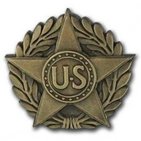
Proudly wearing the World War 1 U.S. Victory lapel pin is
a meaningful way to honor the contributions made for our country one hundred
years ago. Soldiers received Victory buttons upon their discharge from service
in “the Great War”. Hand cast in jeweler’s alloy and hand finished in a satin
bronze patina, the design features the star, symbolizing victory, honor and
glory; a wreath of evergreen laurel leaves symbolizing triumph over death; and the
U.S. insignia, clearly identifying the country served. Measures 1” diameter. A Certificate of Authenticity as Official Merchandise of the United
States World War One Centennial is included.
This and many other items are available as Official Merchandise of the United States World War One Centennial.
|

|
|
|
|
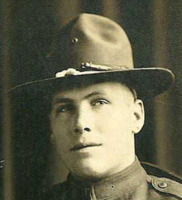
Submitted by: Rebecca Nelson {Granddaughter}
Henry Christian Klindt born around 1894, Henry Klindt served in World War 1 with the United States Army. The enlistment was in 1918 and the service was completed in 1919.
Story of Service
Henry C. Klindt
served as an “Automatic Man” in WWI, U.S. Army National Guard, Company
E, 130th Infantry, 33rd Division from February 26, 1918 to March 21,
1919, arriving in Brest France on May 16, 1918.
Prompted by his cousins, he wrote about his war experiences in a
letter which is attached. He fought in various places in France and his
biggest battle was the Argonne Forest Offensive. He was injured when he
fell on his knees on railroad tracks but his buddies picked him and he
went on.
The last battle he was gassed, picked up unconscious and carried by
his buddies and woke up in a hospital in Vichey France. By the time he
got out, the war was over. Somehow he dodged all the shells and bullets
sent his way, survived near starvation and the nonstop noise of
shelling; being gassed and dealt with not taking his shoes off for 45
days.
|
|
|
|
|